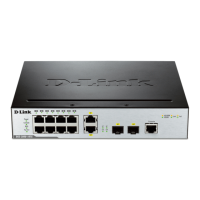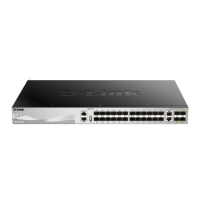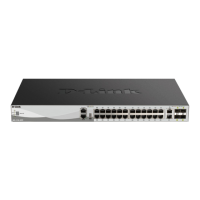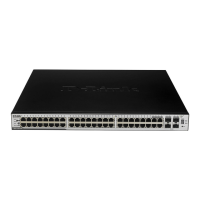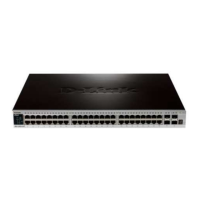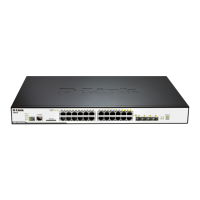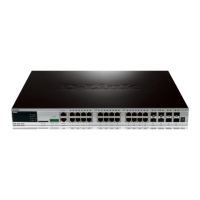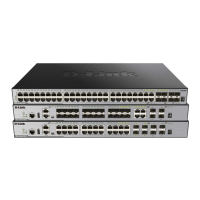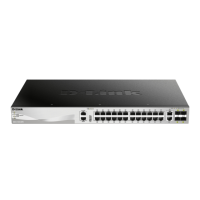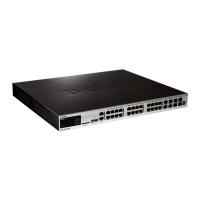Do you have a question about the D-Link DGS-3024 and is the answer not in the manual?
Describes the key features of the DGS-3024 switch, including ports, performance, and management.
Details the types and number of ports available on the DGS-3024 switch.
Highlights the performance capabilities of the switch, such as switching fabric and forwarding rates.
Outlines the management capabilities of the DGS-3024, including console and SNMP support.
Lists the items included in the DGS-3024 switch shipping carton.
Provides guidelines for installing the DGS-3024 switch, including surface and ventilation requirements.
Instructions for installing the switch on a desktop or shelf, including attaching rubber feet.
Steps for mounting the switch in a standard 19-inch rack using mounting brackets.
Details the process of powering on the switch and expected LED indicator behavior.
Describes the components on the front panel, including ports and indicators.
Details the connectors on the rear panel, such as power and RPS connectors.
Describes the side panels of the switch, including fans and heat vents.
Explains the meaning of each LED indicator on the switch's front panel.
Instructions for connecting PCs or routers to the switch's Ethernet ports.
Details on connecting hubs or other switches using various cable types.
Explains how to connect the switch to a core router switch using fiber optic media.
Describes accessing and using the switch's management features via a web browser.
Explains how to manage the switch using SNMP-compatible console programs.
Details connecting to the switch via the serial console port for command-line management.
Guides users through the initial connection process to the switch's console.
Instructions on setting up user accounts and passwords for switch management.
Steps to log into the switch's web-based management interface.
Overview of the user interface for configuring and monitoring the switch.
Description of the three distinct areas within the web manager's main window.
Configures the switch's IP address settings, including manual, BOOTP, or DHCP.
Allows setting basic information like system name, location, and contact details.
Configures advanced switch parameters like serial port settings and web status.
Enables configuration of individual switch ports, including state, speed, and duplex.
Sets up port mirroring to copy traffic from source ports to a target port for analysis.
Configures port trunking to combine multiple ports into a single high-bandwidth link.
Enables and configures IGMP snooping to optimize multicast traffic forwarding.
Configures Spanning Tree Protocol (STP) versions and settings to prevent network loops.
Manages Virtual Local Area Networks (VLANs), including 802.1Q tagging and port settings.
Configures Quality of Service (QoS) settings, including priority queuing and traffic control.
Manages IP addresses allowed to access the switch for management purposes.
Configures SSL for secure communication, including certificate management and ciphersuites.
Sets up SSH for secure remote login and network services, including algorithms and user authentication.
Manages authentication policies, server groups, and login methods for user access.
Manages user accounts, including adding, modifying, and setting access rights (Admin/User).
Configures SNMP settings, including user tables, view tables, group tables, and community tables.
Defines SNMP users, their groups, encryption, and authentication protocols.
Maps SNMP users to views and configures security models and levels for groups.
Displays the percentage of total bandwidth used on each port.
Provides statistics on packet transmission and reception, including bytes and counts.
Shows analysis of received packets, including line graphs and tables.
Shows analysis of transmitted packets, including line graphs and tables.
Displays port error statistics, such as CRC errors, undersize, oversize, and drops.
Shows the switch's dynamic MAC address forwarding table.
Manages TFTP services for firmware upgrades and configuration file transfers.
Instructions for downloading firmware from a TFTP server to update the switch.
Uploads switch settings to a TFTP server for backup.
Saves current switch configuration to NV-RAM to retain changes after reboot.
Provides options for restarting the switch system.
Restarts the switch, potentially losing unsaved configuration changes.
Lists performance metrics like transmission method, RAM buffer, and forwarding rate.
Details physical characteristics and environmental operating conditions.
Provides general specifications including standards, protocols, data rates, and cables.
Specifies maximum cable lengths for Mini GBIC transceivers.
Details warranty terms for hardware defects and materials.
Outlines warranty terms for software conformance and media defects.
Describes the key features of the DGS-3024 switch, including ports, performance, and management.
Details the types and number of ports available on the DGS-3024 switch.
Highlights the performance capabilities of the switch, such as switching fabric and forwarding rates.
Outlines the management capabilities of the DGS-3024, including console and SNMP support.
Lists the items included in the DGS-3024 switch shipping carton.
Provides guidelines for installing the DGS-3024 switch, including surface and ventilation requirements.
Instructions for installing the switch on a desktop or shelf, including attaching rubber feet.
Steps for mounting the switch in a standard 19-inch rack using mounting brackets.
Details the process of powering on the switch and expected LED indicator behavior.
Describes the components on the front panel, including ports and indicators.
Details the connectors on the rear panel, such as power and RPS connectors.
Describes the side panels of the switch, including fans and heat vents.
Explains the meaning of each LED indicator on the switch's front panel.
Instructions for connecting PCs or routers to the switch's Ethernet ports.
Details on connecting hubs or other switches using various cable types.
Explains how to connect the switch to a core router switch using fiber optic media.
Describes accessing and using the switch's management features via a web browser.
Explains how to manage the switch using SNMP-compatible console programs.
Details connecting to the switch via the serial console port for command-line management.
Guides users through the initial connection process to the switch's console.
Instructions on setting up user accounts and passwords for switch management.
Steps to log into the switch's web-based management interface.
Overview of the user interface for configuring and monitoring the switch.
Description of the three distinct areas within the web manager's main window.
Configures the switch's IP address settings, including manual, BOOTP, or DHCP.
Allows setting basic information like system name, location, and contact details.
Configures advanced switch parameters like serial port settings and web status.
Enables configuration of individual switch ports, including state, speed, and duplex.
Sets up port mirroring to copy traffic from source ports to a target port for analysis.
Configures port trunking to combine multiple ports into a single high-bandwidth link.
Enables and configures IGMP snooping to optimize multicast traffic forwarding.
Configures Spanning Tree Protocol (STP) versions and settings to prevent network loops.
Manages Virtual Local Area Networks (VLANs), including 802.1Q tagging and port settings.
Configures Quality of Service (QoS) settings, including priority queuing and traffic control.
Manages IP addresses allowed to access the switch for management purposes.
Configures SSL for secure communication, including certificate management and ciphersuites.
Sets up SSH for secure remote login and network services, including algorithms and user authentication.
Manages authentication policies, server groups, and login methods for user access.
Manages user accounts, including adding, modifying, and setting access rights (Admin/User).
Configures SNMP settings, including user tables, view tables, group tables, and community tables.
Defines SNMP users, their groups, encryption, and authentication protocols.
Maps SNMP users to views and configures security models and levels for groups.
Displays the percentage of total bandwidth used on each port.
Provides statistics on packet transmission and reception, including bytes and counts.
Shows analysis of received packets, including line graphs and tables.
Shows analysis of transmitted packets, including line graphs and tables.
Displays port error statistics, such as CRC errors, undersize, oversize, and drops.
Shows the switch's dynamic MAC address forwarding table.
Manages TFTP services for firmware upgrades and configuration file transfers.
Instructions for downloading firmware from a TFTP server to update the switch.
Uploads switch settings to a TFTP server for backup.
Saves current switch configuration to NV-RAM to retain changes after reboot.
Provides options for restarting the switch system.
Restarts the switch, potentially losing unsaved configuration changes.
Lists performance metrics like transmission method, RAM buffer, and forwarding rate.
Details physical characteristics and environmental operating conditions.
Provides general specifications including standards, protocols, data rates, and cables.
Specifies maximum cable lengths for Mini GBIC transceivers.
Details warranty terms for hardware defects and materials.
Outlines warranty terms for software conformance and media defects.
| Ports | 24 |
|---|---|
| Uplink Ports | 4 |
| Switching Capacity | 48 Gbps |
| Forwarding Rate | 35.7 Mpps |
| MAC Address Table Size | 16K |
| Jumbo Frame Support | Yes |
| Power Consumption | 30W |
| Power Supply | Internal |
